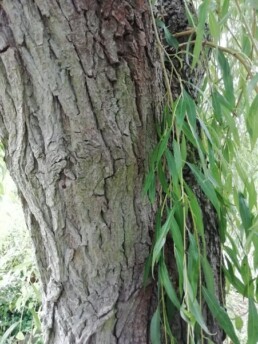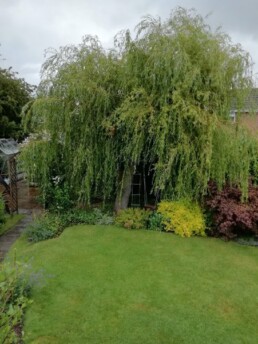16 – Salix babylonica / Weeping or Chinese Willow
Beware of a sheep in wolves clothing sums this one up. Looks magnificent but all is not what it seems, and I have one in my garden! So here goes: –
Salix babylonica Weeping or Chinese Willow
Is a medium to large-sized deciduous tree, growing up to 82 ft tall. It grows rapidly, but has a short lifespan, between 40 and 75 years. The trunk can be up to 3 ft. thick often leaning and covered with deeply fissured bark, supporting a vast spreading “weeping crown” with the branches reaching the ground. Branches will vary in thickness and flexibility from top to bottom when at ground level they are as thin as grass. These shoots are yellowish-brown, with small buds. The leaves are alternate and spirally arranged, narrow, light green, 1 – 6 in long x 1 in wide, with finely serrated margins and long pointed tips; they turn a gold-yellow in autumn. The flowers are arranged in catkins produced early in the spring; it is dioecious, with the male and female catkins on separate trees. Willow timber is useless however young willow shoots have been used for centuries for basket making but not of this tree.
You will see this tree in many a public park especially beside a lake or stream because they love water. They look so graceful and innocent wafting their pendulous hair in the breeze across the water don’t they? You can understand why then it is the tree that the willow pattern porcelain from China is based on. The one in my garden grows in a natural spring course and I must completely denude it of branches every two years, but back they all come again as vigorous as ever ready for the next time. But do I want my garden to be flooded?
Then there are the roots of this willow, and any other like it. They seek out water like no other tree does. They will send out small fibrous investigative roots in every direction as far and wide until a good source of water is found, be that a spring, a crack in a drain, a water main, or even a sewer, then all the resources and growing strength of the tree will be sent to that point to feed the whole tree, with the roots expanding in in all directions at that point. They can be so destructive. You only need to ask our dear brother Josh Newborough to confirm that.
Using the King James translation in Psalm 137 we read how the nation of Israel remembering Zion wept whilst in exile in Babylon and in so doing hung their harps on willows along their rivers. This was because of their lovely appearance as described above. Weeping willows never got to Babylon, but as a former Fellow of the Linnaean Society I was encouraged to read that Carl Linnaeus read the bible to correct this error. So, from the Revised King James translations onwards it says Poplars. These Poplars are remarkably similar in shape size and habit, known as Tamarisk, a subspecies of the willow family and were easily confused.
The Nation of Israel were yearning to go back to how things were when they saw these lovely weeping trees by these rivers in Babylon but felt they could not worship. They felt as if their water supply had been cut off. That their mouths were too dry to sing as Psalm 42 says. As we all begin to take tentative steps out of lockdown and start reaching for that little bit of fresh water but still have restrictions on worship, we may feel the same, well, I have got news for you. My bible tells me that you can command your innermost being, your soul, your tree, your whole body, and your whole being, your roots, to Praise God and it is found in Psalm 42. As the Deer pants for the Water….





